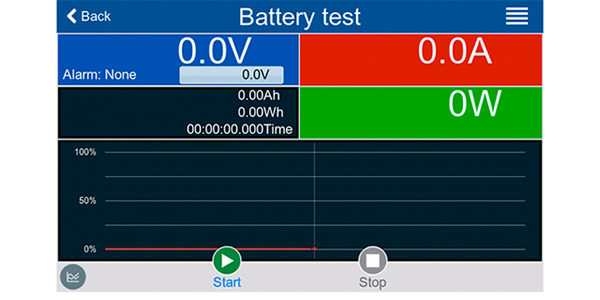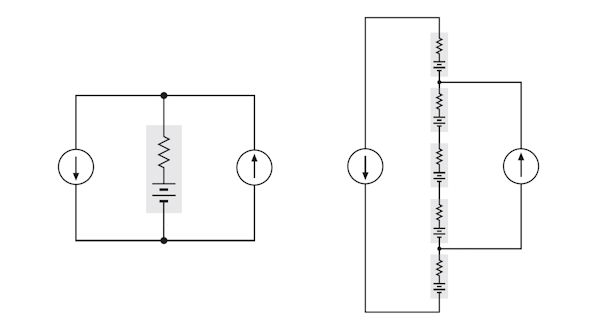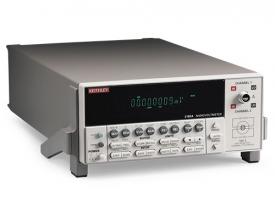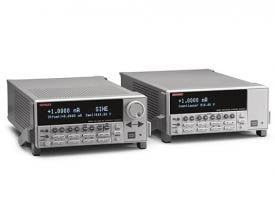Contactez-nous
Chat en direct avec un représentant Tek. Service disponible de 9 h à 17 h, CET jours ouvrables.
Appelez-nous au
Disponible de 9 h à 17 h CET jours ouvrables.
Télécharger
Télécharger des manuels, des fiches techniques, des logiciels, etc. :
Feedback
Utilisez l'hydrogène propre pour exploiter la puissance de la chimie
Les piles à hydrogène sont un des types de piles à combustible qui constituent la pierre angulaire des solutions modernes en matière d'énergie propre. Ils transforment l'énergie chimique des combustibles en énergie électrique grâce à des réactions électrochimiques. Contrairement à la production d'électricité par combustion classique, les piles à combustible produisent de l'électricité avec un rendement plus élevé et des émissions nettement plus faibles, ce qui les rend essentielles pour les systèmes énergétiques durables.
Cependant, tout comme les sources d'énergie traditionnelles, les systèmes de piles à combustible nécessitent des tests approfondis pour garantir qu'ils fournissent les performances, la durabilité et la longévité nécessaires à l'utilisation prévue. En mettant en place un programme de tests rigoureux, vous pouvez garantir que vos conceptions respectent les normes réglementaires tout en optimisant la qualité des produits.
Techniques de développement de piles à combustible
Tester des piles à combustible complètes
Le marché des piles à combustible connaît actuellement une croissance énorme, de l'ordre de 30 %, due à des facteurs tels que les initiatives gouvernementales, les incitations économiques et les nouvelles applications. Dans des domaines tels que les camions industriels, les véhicules de livraison, les camions longue distance et les générateurs d'énergie de secours, les piles à combustible à hydrogène apportent des avantages intéressants en termes de coûts d'exploitation, d'efficacité et de compensation carbone. L'importance d'assurer la flexibilité tout en conservant des coûts d'exploitation réduits a considérablement augmenté dans l'ensemble de l'industrie. Une indication courante des performances d'une cellule est la polarisation et les courbes de densité de puissance de la pile à combustible. Ces courbes sont généralement évaluées dans les conditions optimales de fonctionnement (température, humidité, électrocatalyse et membrane échangeuse d'ions) d'une pile à combustible.
En programmant des charges électroniques DC telles que celles de la série EA ELR 10000 dans différents profils de courant ou de résistance, ces mesures peuvent être facilement obtenues. Ces charges électroniques sont idéales pour les tests de piles à combustible avec une puissance d’entrée allant jusqu’à 30 kW, qui peuvent être étendues dans un système jusqu’à 3,84 MW. Un générateur de formes d'ondes arbitraires intégré permet d'effectuer des essais dynamiques, tandis que les capacités de régénération permettent de récupérer jusqu'à 96 % de l'énergie des piles à combustible qui serait autrement perdue sous forme de chaleur.
Évaluer le vieillissement des piles à combustible pour en assurer la durabilité
Il est toujours nécessaire d'effectuer le test de durabilité des piles à combustible pour assurer la sécurité et la stabilité du produit. La pile à combustible est souvent la source d'énergie active dans les applications. Le test de durabilité d'une pile à combustible peut être un processus long qui peut entraîner des coûts d'exploitation très élevés pour un système de pile à combustible typique de 100 kW. La norme automobile exige 5 000 heures (~7 mois) et les applications de stockage stationnaire nécessitent plus de 10 000 heures. Même en utilisant des cycles de potentiel par paliers et triangulaires pour réduire le temps des tests de durabilité, il peut y avoir une perte d'énergie substantielle au cours des tests.
Les charges électroniques régénératives avec générateurs de fonctions intégrés comme la série EA ELR 10000 sont idéales pour ces situations. La technologie régénérative permet de capter jusqu'à 96 % de cette énergie perdue pendant le cycle, qui serait autrement perdue en chaleur. Un générateur de fonctions intégré permet de réaliser des profils de test accélérés (comme des formes d'ondes en escalier ou triangulaires) tout en permettant d'obtenir des mesures de l'énergie accumulée via une fonction de test de décharge.
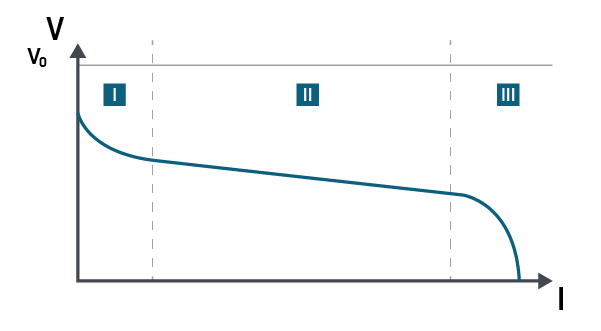
I : La cellule montre une chute de tension non linéaire avec l'augmentation du courant. II : La résistance ohmique prédomine avec une relation V/I linéaire. III : La tension diminue de façon exponentielle, car la réaction chimique ne peut plus fournir d'énergie supplémentaire.
En savoir plus :
Simulation de piles à combustible
Lorsque l'on travaille avec la technologie des piles à combustible, il est inévitable que la fiabilité de ces systèmes électrochimiques entre en jeu. La capacité de simuler des piles à combustible en interaction avec le reste du système énergétique peut réduire le temps de développement et améliorer la fiabilité du système global.
Les alimentations de la série EA PSI 10000 incluent la capacité de fonctionner avec une table UI (ou tension-courant) qui ajuste la tension de sortie en fonction des variations du courant mesuré. Cela permet de simuler la sortie d'une pile à combustible en modélisant la courbe de polarisation.
Les alimentations bidirectionnelles EA permettent à la fois de simuler la sortie d'une pile à combustible et de récupérer de manière régénérative l'énergie produite par la pile à combustible. Cela permet à un seul instrument ou rack d'équipement de remplir une double fonction pour des systèmes allant de 30 kW à 3,84 MW.
Comprendre les mesures de cellules individuelles
Toute personne impliquée dans la conception, la fabrication, l'application ou la réparation de piles à combustible, ou d'appareils alimentés par des piles à combustible, a besoin de données sur les piles qui ne sont disponibles que par des mesures électriques directes. Lorsqu'elles sont correctement interprétées, ces données permettent non seulement de comprendre comment et pourquoi les piles à combustible fonctionnent, mais aussi d'indiquer l'état des piles en fonctionnement, d'aider à prédire leur durée de vie, de révéler les mécanismes de défaillance et de donner un aperçu de leur adéquation à des applications spécifiques.
Des instruments tels que la source de courant AC+DC Keithley 6221, le nanovoltmètre 2182A et l'unité de source et de mesure 2450 sont des outils inestimables pour effectuer la caractérisation électrique précise des piles à combustible individuelles, nécessaire pour comprendre les processus électrochimiques en jeu.



